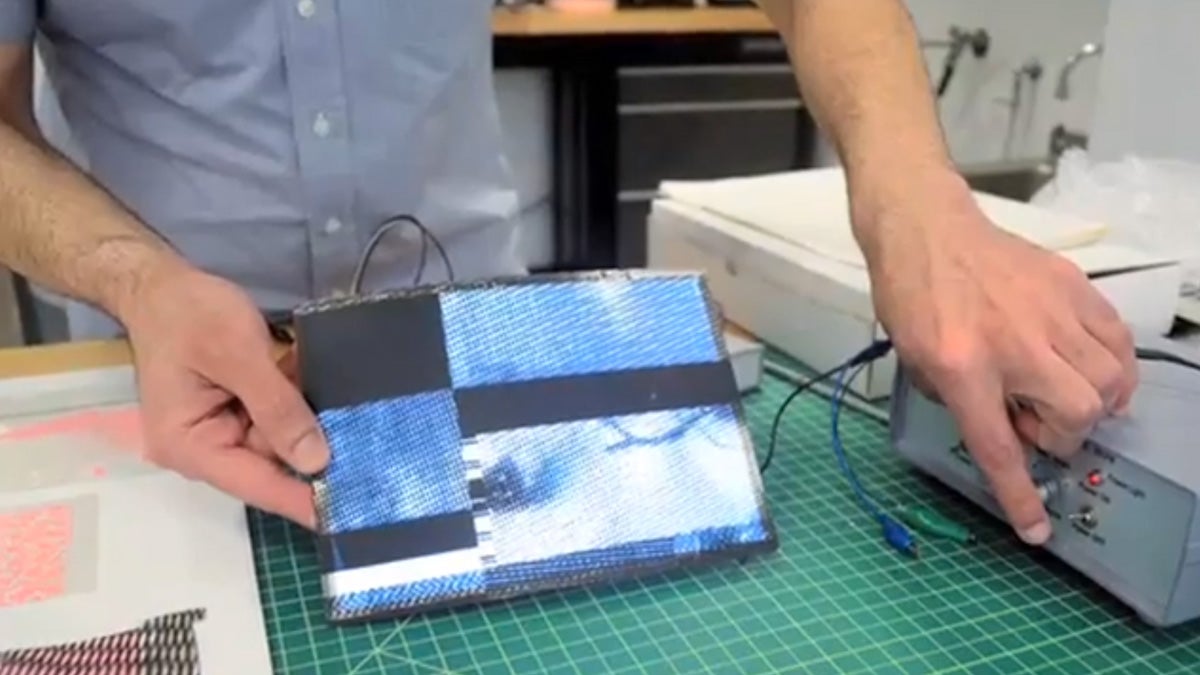Penn professor animates silkscreens with glowing, changing light

What if Andy Warhol’s iconic silkscreen prints could glow and change color? That’s the effect that Orkan Telhan is going for with his electroluminescent art.
Telhan, an artist and assistant professor of fine arts at the University of Pennsylvania, works at the intersection of design and engineering. For his latest project, he used electroluminescent inks to create silkscreen prints that glow when exposed to electrical current.
The secret is bright pink, paintable phosphor. “We start with a single sheet of transparent film that is coated with a special conductive ink,” Telhan says.
On top of that, he paints on the phosphor, then a layer of dielectric paint to insulate the phosphor, and then a layer of silver.
“Think of a sandwich,” Telhan says. The silver and the transparent film are the electrically conductive bread — they create an electric field that causes the phosphor in between to light up.
“Phosphor is the only thing that can do that,” Telhan says.
He has also made electrochromic prints, which change opacity when exposed to electricity. For those prints, he used liquid crystals.
Telhan’s electrochromic silkscreens are usually a shade of opaque, milky white. But when exposed to an electrical field, the crystals realign to let light shine through. The print becomes transparent.
Telhan says that the technology isn’t new. What is new is Telhan’s approach. Smart materials such as paintable phosphor and liquid crystals “are usually designed by designers or engineers who really have no aesthetic concerns,” Telhan says.
And although you could get a similar effect on your iPhone, Telhan says that’s beside the point. “Yes, you can use your tablet, laptop and all sorts of devices for this.”
But, Telhan says, “I’m interested in really how we can extend this whole medium of communication and exchange using electrical devices but increase the vocabulary with new kinds of materials and new kinds of interfaces.”
Imagine you’re at a nice café, and “you see these amazing posters on the wall coming from the 19th century, and all of these amazing graphics,” Telhan says. “No one really puts a giant TV screen there.”
Telhan envisions his silkscreen prints going beyond art that people can admire. If you attach a microcontroller to these prints, you can program them to do just about anything. Telhan is working on with turning his prints into hands-on, interactive games.
At this stage, he’s still experimenting with the possibilities. And the prints are only a small part of what he does.
His other projects include incorporating synthetic biology, glowing and shape shifting liquids and “all kinds of mad scientist stuff.”
With all his work, Telhan aims to meld the artistic with the technical and the scientific.
It’s fitting, then, that in order to make the silkscreens, Telhan collaborated with Penn’s Common Press–a leterpress and print-making studio dedicated to preserving old-school printing techniques.
“I really want a new breed of designers or artists who can go back and forth between different technologies, different materials, different media,” he says. “And really be very brave and curious about what is possible.”
WHYY is your source for fact-based, in-depth journalism and information. As a nonprofit organization, we rely on financial support from readers like you. Please give today.




